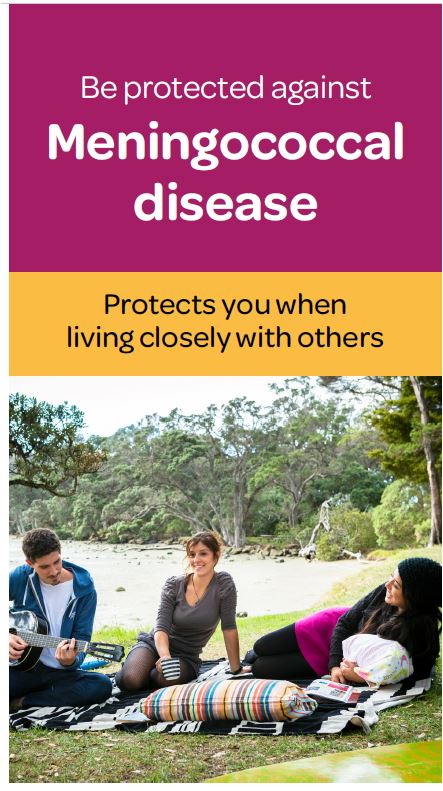Bexsero is a vaccine that protects against meningococcal B, a bacteria which causes meningococcal disease. Meningococcal disease can develop suddenly and become deadly in just a few hours. Read more about meningococcal disease.
There are at least 12 groups of meningococcus designated with letters such as A, B, and C. In Aotearoa New Zealand, Group B causes the highest incidence of meningitis cases. Bexsero together with other meningococcal vaccines protects you against meningococcal disease and helps stop it spreading to others. Read more about meningococcal vaccines.
We're aware of a problem when trying to use Zero Data to link to Healthify. Zero Data is managed by Health NZ and we are working with them to get this fixed.
Bexsero
Be protected against meningococcal disease
Key points about Bexsero
- Bexsero is a vaccine that protects against meningococcal B.
- Find out about Bexsero and possible side effects.

Bexsero can be given to anyone aged 2 months or older, but it is only funded for the groups below. If you, or your tamariki, are not eligible to receive Bexsero for free, talk to your healthcare provider about whether extra protection is a good idea and what it might cost.
Bexsero is part of the childhood immunisation schedule for babies
Bexsero is part of the childhood immunisation schedule for babies and is given at age 3 months, 5 months and a booster at 12 months. It will protect your pēpi (baby) against meningococcal B.
You can have your baby immunised earlier – at 2 months, 4 months, and 12 months old. This will mean extra appointments, because other vaccines are not due at 2 and 4 months. Discuss this with your healthcare provider during your baby’s 6-week immunisations if you want to have them earlier.
Tamariki under 5 years old
All tamariki under 5 years old, who have not had 3 doses as part of the childhood immunisation above, can catch up for free until 31 August 2025.
The number of doses given will depend on their age.
- Tamariki over 2 years get 2 doses, 8 weeks apart. Booster doses are funded for high-risk groups.
- Tamariki younger than 2 years get 3 doses. The first two doses are given 8 weeks apart and a third booster dose is given 12 to 23 months after the second dose.
People aged 13 to 25 years in a close-living situation
Bexsero is also funded for people from 13 to 25 years of age who are currently living in boarding school hostels, tertiary education halls of residence, military barracks or prisons, from 1 March 2023 until 28 February 2024 as a catch up. It is recommended that they receive 2 doses of the Bexsero vaccine – the second dose can be given 8 weeks after the first dose. Menactra® or MenQuadfi® vaccines are also recommended and is free for this group. Read more about meningococcal vaccines.
Tamariki and adults with high risk medical conditions
Bexsero may also be available and free for children and adults who are at high risk of disease due to medical conditions, or people who’ve been in close contact with someone with meningococcal disease. Ask your healthcare provider for more information.
Bexsero is given by injection usually into your or your child's arm or leg muscle. For older people, it is given in the upper arm. Bexsero can be given at the same visit as other vaccines in separate syringes and at separate injection sites.
The number of doses given will depend on their age.
- Adults and tamariki over 2 years get 2 doses, 8 weeks apart. Booster doses are funded for high-risk groups.
- Tamariki younger than 2 years get 3 doses. The first two doses are given 8 weeks apart and a third booster dose is given 12 to 23 months after the second dose.
Funded and unfunded Bexsero vaccines can be given by your nurse, doctor, healthcare provider, and some pharmacies.
Find a provider near you on the Healthpoint(external link) website by entering your address.
- If you're eligible for a free vaccination, there won't be a cost for Bexsero, but there may be an administration fee.
- If you're not eligible to get a free vaccination, you will need to pay.
- Pharmacists who are trained as vaccinators can administer the Bexsero vaccine to people aged 16 years and over.
- A small number of pharmacists who have done extended training can administer any vaccination on the National Immunisaton Schedule(external link), including those for babies. Always call your pharmacy ahead of time to find out if they offer this service, the cost and whether you need to make an appointment.
Vaccines on the National Immunisation Schedule(external link) are free. Other vaccines are funded only for people at particular risk of disease. You can choose to pay for vaccines that you're not eligible to receive for free.
Like all medicines, Bexsero can cause side effects, although not everyone gets them. The chance of a severe reaction from Bexsero is very small, but the risks from not being vaccinated against meningococcal disease may be very serious.
Fever
Fever can occur in some infants as part of their normal response to Bexsero, usually especially around 6 hours after immunisation and settling over 24 to 48 hours. This is more likely to happen in children under 2 years; routine use of paracetamol is recommended in this age group.
For children under 2 years of age, give paracetamol to reduce the risk of high fever. Three doses of paracetamol are recommended. The first dose should be given from 30 minutes before Bexsero, or the vaccinator can give this at the time the injection is given or just after. The second dose of paracetamol should be given 6 hours later, and the third dose, 6 hours after that.
- A fever over 38°C is more likely to occur in infants and children aged under 2 years after immunisation with Bexsero compared with other routinely used infant vaccines.
- When Bexsero is administered at the same time as other vaccines, a fever over 38°C is almost twice as likely as when other vaccines are given alone.
For children over 2 years of age: Routine use of paracetamol isn't recommended, but paracetamol may be given if your child is unwell or miserable with a fever.
Read more about the safe use of paracetamol in children and paracetamol use with Bexsero. (external link)
Other ways to manage fever
- Dress your child lightly, with a single layer of clothing. Make sure the room is not too hot or too cold. Give lots of breastfeeds or fluids.
- Tell your healthcare provider if the fever persists.
- Read more about what happens after your immunisation.(external link)
Other side effects
| Side effects | What should I do? |
|---|---|
|
|
|
|
|
|
Read more about medicines and side effects and reporting a reaction you think might be a side effect.
References
- Bexsero(external link) Immunisation Advisory Centre
- MenB Bexsero quick facts(external link) Immunisation Advisory Centre
Brochures

Health Promotion Agency and Te Whatu Ora, NZ, 2022

Medicines and side effects
Healthify He Puna Waiora, NZ, 2024

Health Quality and Safety Commission, NZ, 2019 English, te reo Māori
Credits: Sandra Ponen, Pharmacist, Healthify He Puna Waiora. Healthify is brought to you by Health Navigator Charitable Trust.
Reviewed by: Angela Lambie, Pharmacist, Auckland
Last reviewed:
Page last updated:





